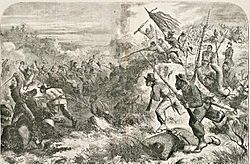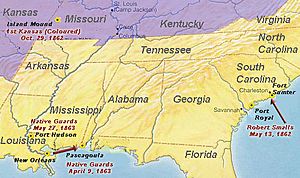Skirmish at Island Mound facts for kids
Quick facts for kids Skirmish at Island Mound |
|||||||
|---|---|---|---|---|---|---|---|
| Part of the Trans-Mississippi Theater of the American Civil War |
|||||||
 A woodcut depicting the battle published in Harper's Weekly in 1863 |
|||||||
|
|||||||
| Belligerents | |||||||
| Commanders and leaders | |||||||
| Richard G. Ward Henry C. Seaman |
Jeremiah V. Cockrell Dick Hancock Bill Truman |
||||||
| Units involved | |||||||
| 1st Kansas Volunteer Infantry Regiment (Colored) | Missouri State Guard | ||||||
| Strength | |||||||
| 250 | ~350 | ||||||
| Casualties and losses | |||||||
| 8 killed 11 wounded |
estimated 30-40 killed, unknown wounded | ||||||
The Skirmish at Island Mound was a small but very important battle during the American Civil War. It happened on October 29, 1862, in Bates County, Missouri. This battle was a victory for the Union army.
It is famous because it was the first time an African-American regiment fought in combat against Confederate forces. Most of these soldiers were former slaves who had escaped from Missouri and Arkansas. They had recently trained in Kansas. Even though they were outnumbered, they fought bravely. The New York Times newspaper even wrote about their "desperate bravery." This Kansas regiment later became part of the Union Army as United States Colored Troops. Today, the area where the battle happened is a preserved historic site called the Battle of Island Mound State Historic Site.
Contents
How the Battle Started
Captain James M. Williams was putting together a group of African-American soldiers in Kansas. Many of these men were escaped slaves from Missouri, Arkansas, and Indian Territory. Some were also free black men. In August 1862, they joined the Kansas militia as the 1st Kansas Colored Volunteers.
At first, the United States government was not ready to have black soldiers in the Union Army. They officially joined the U.S. Army on January 13, 1863, after the Emancipation Proclamation. Even so, Kansas made sure these men had good muskets and bayonets.
Major B.S. Henning ordered two groups of soldiers to go into Bates County, Missouri. Captain Richard G. Ward led 170 men, and Captain Henry C. Seaman led 70 men. They were joined by 5th Kansas Cavalry scouts, including some Cherokee and black soldiers. Their goal was to break up a guerrilla (fighter) group. This group was based on Hog Island in the Osage River. The area was mostly open grassland and farms.
On October 27, the Kansas scouts saw a large group of local Confederate guerrillas. These were led by Bill Truman and Dick Hancock. There were also Missouri State Guard recruits led by Colonel Jeremiah "Vard" Cockrell. All of these enemy fighters were on horseback.
The Fight at Island Mound
The Kansas soldiers realized the enemy was stronger than they expected. So, they quickly built defenses around the Toothman homestead. They used fence rails to make strong walls, which they called "Fort Africa." The next day, Tuesday, there were small fights. The Kansas soldiers had better guns, which kept the enemy cavalry away.
By Wednesday, October 29, the Kansas soldiers were running low on food. They had sent messengers to Kansas asking for help. A group went out to find food, while other soldiers fought to distract the enemy. After the food group returned, the men ate.
While the Kansas soldiers ate, the guerrillas started a prairie fire south of the camp. This fire pushed the Kansas fighters back. Captain Seaman started a controlled fire to stop the main fire from reaching their camp. He sent out a scouting party, including a Cherokee man named John Six-Killer and his slaves who had joined the army. This group was supposed to stay in sight of the camp. But they got into a fight and moved out of sight.
Lieutenant Joseph Gardner and other officers went to help them. This group also got into a fight and moved out of sight. Captain Ward then went to help them. He saw the others fighting far from camp. He called for the rest of his soldiers to come forward. Captain Seaman sent his men to support them from the sides.
The enemy cavalry appeared in large numbers. They moved between Gardner's group and Ward's group. Gardner's men tried to get back to camp. When they couldn't, they formed a line and fired their guns at the charging cavalry. The Kansas men were greatly outnumbered. A big fight broke out, and most of the Kansas losses happened here. The enemy cavalry that got past Gardner found themselves trapped by shots from the rest of the Kansas soldiers. Gardner's group moved toward the advancing line, and the guerrillas were finally forced to leave.
Who Was Lost and Why It Mattered
The Union army lost 8 soldiers: 1 white officer, 6 black soldiers, and 1 Cherokee soldier. 11 men were wounded. Among those who died were Captain A.G. Crew, Corp. Joseph Talbot, Privates Samuel Davis, Thomas Lane, Marlon Barber, Allen Rhodes, Henry Gash, and John Six-Killer. We don't know how many guerrillas were lost, but some Kansas soldiers at the time thought up to 40 were killed.
The New York Times reported on the battle. The newspaper praised the African-American soldiers for their "desperate bravery." Bill Truman, one of the enemy leaders, even told his supporters that the black soldiers fought "like tigers." These African-American soldiers were fighting for their freedom. They knew the guerrillas would not take them prisoner, but would kill them.
The bravery of this unit got national attention. Some people had doubted if former slaves could be good soldiers. But Island Mound proved they could. In 1863, the United States Colored Troops were officially created. On December 13, 1864, the 1st Kansas Colored Volunteers became the 79th United States Colored Troops.
Honoring the Past
- The Battle of Island Mound State Historic Site was created in 2012 in Bates County. It helps preserve this important area. It honors all the soldiers, especially the eight Kansas soldiers who died and were buried near the Toothman farm.
Island Mound in Movies
- The Battle of Island Mound (2014) is a 30-minute movie. The Missouri Department of Natural Resources asked for it to be made. Brant Hadfield, a filmmaker from St. Louis, made the film. He wrote, directed, filmed, and edited it. It won two Emmy Awards in 2015 for Best Historical Documentary and for its filming. It has also won other awards.
Images for kids




